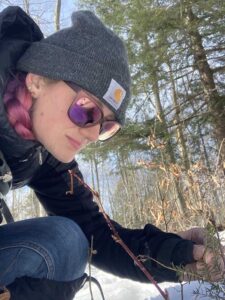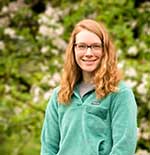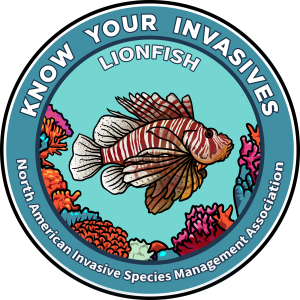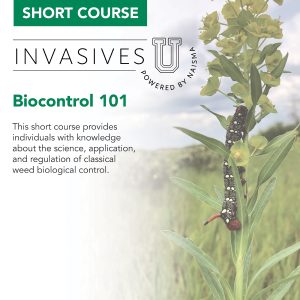Hemlock Woolly Adelgid – Making its Way North in Michigan
For the Northwest Michigan Invasive Species Network (ISN), winter management efforts are focused primarily on surveying for hemlock woolly adelgid (HWA). In a previous blog post, we discussed what HWA looks like, how it spreads, and how regional conservation organizations are teaming up to identify any potential new populations of this tiny invasive insect in northern Michigan. Operating with funds from the Michigan Invasive Species Grant Program (via the Ottawa Conservation District), ISN has been working to stay ahead of hemlock woolly adelgid since the fall of 2018. With populations of HWA creeping up the Lake Michigan shoreline, surveying trees is prioritized with the hope that the insect’s spread can be stopped with early detection efforts.
Stopping Spread in its Tracks with Early Detection

HWA surveys primarily take place in the winter, when insects are dormant and the risk of picking up invasive hitchhikers is less. Surveyors spend all day in the woods, carefully checking the undersides of hemlock branches. They are looking for the tiny egg sacs of the adelgid which, if present, would be found near the base of the needle. Most of the time, nothing is found. Sometimes a closer look is required to make sure any white is simply snow or perhaps spider eggs. That is how early detection works. Invasive species managers check everything with the hope that nothing unexpected is found. Until they do find something.
In early February of this year, a survey crew from Sleeping Bear Dunes National Lakeshore, an ISN partner, was checking hemlock trees within one of their campgrounds. A branch was flipped over and to everyone’s surprise, HWA was obvious at the base of the needles. A sample was taken to submit to the state (which mobilized quickly) for confirmation, and soon it was announced that an entirely new population of HWA was found within the National Lakeshore – a full county north of where it had previously been detected.
The news of this discovery was disappointing. However, from a management perspective, early detection efforts worked exactly as they were supposed to. A new population of HWA had been found, and partners immediately began making plans for treatment to stop any further spread. It is believed the insect has not even had a chance to spread beyond that single tree. We consider this a resounding success!
That is how early detection works. Invasive species managers check everything with the hope that nothing unexpected is found.
Emily Cook Tweet
A Community Rallies
Outreach and education are an essential component of invasive species management, especially when a new population of a high-priority insect or plant is found. Following the discovery of HWA in the National Lakeshore, neighboring property owners were notified, and ISN made a call for volunteers who were interested in utilizing community (formerly citizen) science methods to survey hemlock trees on their own property.
The response was strong and immediate. So much so, that ISN began to work with Michigan State University Extension to develop an online community survey form via their “Eyes on the Forest” program. This way, folks could check their own trees, input data, and any information would immediately be sent to ISN and its partners. After a webinar was held to explain the process, people from throughout northwest Michigan took to their own properties and nearby public lands to check hemlock trees for HWA.

What Happens Next?
As we venture further into the spring months and temperatures warm, surveying is coming to a halt. Soon, HWA crawlers will become active and the risk of spread returns. However, ISN leaves this survey season feeling confident that through a combination of proper surveying techniques, outreach, and community support, northwest Michigan’s special hemlock trees remain safe for another season.
Regardless, it is still so critical for all to be aware of the steps that can be taken to minimize the risk of HWA (or any invasive species). Decontamination and prevention efforts should be stringent, especially in areas where it is known to be prevalent, such as the Eastern US. In the case of the population appearing in Sleeping Bear Dunes National Lakeshore, it most likely arrived via a camper who unknowingly transported the insect from downstate Michigan. Low hanging trees can have lower branches trimmed, all vehicles and gear should be cleaned before moving between new locations, and if possible, a change of clothes and shoes should be available as well.
Additionally, there are some other ways to prevent the spread of invasive species, in general:
- Before leaving a site, regardless of recreation type, clean all your gear (and you!) thoroughly.
- Never bring firewood from home to your campsite. Buy it where you burn it.
- Do not move any firewood further than 10 miles from where it originated.
- Do not forget to brush any debris off your pets – seeds and insects love a long fur coat.
- Spray down your vehicle or camper to remove any tiny hitchhikers.
(Find more invasive species prevention tips on the PlayCleanGo website.)
If you are interested in learning more about surveying efforts, Eyes on the Forest is a great place to start, even if you are not in Michigan. Similar programs exist throughout different management areas and it can serve as wonderful inspiration on how to get involved with invasive species control in your own area.

Emily Cook
Emily Cook is ISN’s Outreach Specialist, based out of Traverse City, Michigan, and has worked in the realm of invasive species for more than ten years. She also serves on the Board of Directors for the Midwest Invasive Plant Network.




